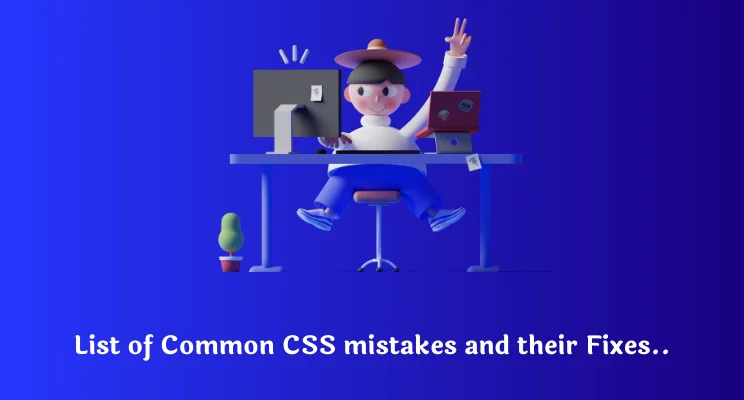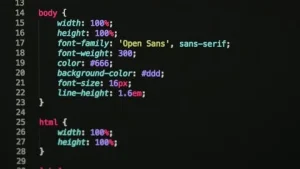CSS (Cascading Style Sheets) is the backbone of web design, controlling the layout, colors, spacing, and overall visual presentation of a website. Mastering CSS is essential for any web developer aiming to create responsive, accessible, and visually appealing websites. However, despite its flexibility, CSS can easily become messy and difficult to manage without a solid understanding of best practices.
Writing clean, maintainable, and error-free CSS not only improves performance but also makes it easier to scale and debug your projects. Unfortunately, many developers especially beginners fall into common traps that lead to inconsistent styling, bloated code, and cross-browser issues.
In this article, we’ll explore some of the most Common CSS Mistakes and How to Avoid Them. From specificity problems and poor structure to performance pitfalls and accessibility oversights, you’ll learn practical tips to write better, more reliable CSS for your web projects.
Dreaming of a career in software development? Turn that dream into reality with our immersive software engineering course in Kenya. With a focus on real-world projects and hands-on learning, you’ll be job-ready in as little as 10 to 12 months.
Common CSS Mistakes and How to Avoid Them
1. Poor Use of Specificity
Specificity in CSS determines which styles are applied when multiple rules target the same element. It’s calculated based on the type of selectors used, inline styles, IDs, classes, attributes, and elements, all carry different weights. Understanding this hierarchy is crucial for predictable styling.
Common Mistake:
One of the most frequent errors is the overuse of !important to force styles to apply. While it may seem like a quick fix, it creates rigid, hard-to-maintain code and often leads to conflicts, especially in large stylesheets.
How to Avoid It:
- Avoid relying on !important unless absolutely necessary (e.g., utility classes or third-party overrides).
- Use well-structured, meaningful class names rather than targeting IDs or deeply nested elements.
- Learn and apply the specificity hierarchy:
Inline styles > IDs > Classes/attributes > Elements - Consider using methodologies like BEM or SMACSS to organize styles cleanly.
Mastering specificity leads to more maintainable and scalable CSS, reducing the need for hacks and overrides.
2. Not Using a CSS Reset or Normalize
Mistake:
One of the most overlooked issues in CSS development is failing to reset or normalize styles. Browsers apply their own default styles to HTML elements like margins, paddings, font sizes, and heading styles which can lead to inconsistent appearances across different browsers.
Why It’s a Problem:
These default styles vary from browser to browser, which means your layout may look perfect in Chrome but broken in Firefox or Safari. Without a consistent baseline, even simple UI elements can behave unpredictably.
How to Avoid It:
- Use a CSS reset (e.g., Eric Meyer’s Reset) to remove all default styling and start from scratch.
- Or, use normalize.css, which preserves useful defaults while fixing inconsistencies between browsers.
- Apply your reset or normalize styles at the very top of your main stylesheet.
By establishing a consistent starting point, you reduce cross-browser bugs and ensure your styles behave predictably across devices.
3. Overly Complex Selectors
Mistake:
A common CSS mistake is writing deeply nested or overly specific selectors—for example, .container .content ul li a span. While this might seem precise, it often results in bloated code that’s difficult to override or reuse.
Why It’s a Problem:
- Harder to maintain: A small change in HTML structure can break the styles.
- Low reusability: Styles tied to specific element hierarchies can’t be applied elsewhere.
- Increased specificity: Makes it harder to override styles without using !important or even more complex selectors.
How to Avoid It:
- Keep selectors short and meaningful: Prefer .button over .main .section .content .button.
- Use reusable class-based selectors rather than relying on element nesting.
- Adopt naming conventions like BEM (Block Element Modifier) to organize and simplify your CSS.
Simple, flat selectors lead to more flexible and maintainable code—and they’re easier for teams to understand and work with.
4. Ignoring Mobile Responsiveness
Mistake:
One of the biggest CSS mistakes is designing websites solely for desktop screens. Developers often build layouts that look great on large monitors but break or become unusable on tablets and smartphones.
Why It’s a Problem:
- Mobile devices account for over half of global web traffic.
- Poor mobile experience leads to high bounce rates and lost users.
- Search engines like Google prioritize mobile-friendly sites in search rankings.
How to Avoid It:
- Use media queries to adapt layouts, font sizes, and spacing for various screen widths.
- Adopt a mobile-first approach: Design for smaller screens first, then progressively enhance for larger ones.
- Utilize flexible units like %, em, and rem, and avoid fixed widths where possible.
By ensuring your CSS adapts to all screen sizes, you’ll deliver a consistent, user-friendly experience that works on any device.
5. Not Organizing CSS Properly
Mistake:
Dumping all your styles into one long, unstructured CSS file is a common mistake, especially in early-stage or small projects. While it may seem manageable at first, the file quickly becomes messy and difficult to work with as the project grows.
Why It’s Inefficient:
- Makes debugging and locating specific styles time-consuming.
- Leads to duplicated code and style conflicts.
- Difficult to onboard other developers or scale the codebase over time.
How to Avoid It:
- Use modular CSS by breaking styles into multiple files (e.g., layout, components, utilities) and importing them as needed.
- Follow a naming convention like BEM (Block Element Modifier) to maintain clarity and consistency in selectors.
- Consider using CSS preprocessors like SASS or LESS to organize code into partials, use variables, and improve maintainability.
A well-structured CSS architecture not only improves productivity but also keeps your project scalable and easier to manage in the long run.
6. Failing to Use Variables and Reusable Values
Mistake:
Hardcoding values like colors, font sizes, or spacing throughout your stylesheet may seem faster at first, but it leads to inconsistency and inefficiency. If you repeat the same hex code or pixel value in dozens of places, a simple design change becomes a tedious, error-prone task.
Why It’s Bad:
- Difficult to make global changes, every instance must be updated manually.
- Increases the risk of inconsistencies in your design
- Makes collaboration harder due to lack of shared design tokens.
How to Avoid It:
Use CSS custom properties (variables) to define values in one place and reuse them throughout your stylesheets:
:root {
--primary-color: #3498db;
--spacing-unit: 1rem;
}
.button {
background-color: var(--primary-color);
margin: var(--spacing-unit);
}If you’re using a preprocessor like SASS, take advantage of variables:
$primary-color: #3498db;
$spacing-unit: 1rem;Using reusable values improves consistency, makes your CSS easier to maintain, and allows for quick design updates with minimal effort.
7. Neglecting Performance Optimization
Mistake:
A common but often overlooked mistake is ignoring how CSS impacts site performance. Unused styles, bloated files, and excessive animations can significantly slow down your website, especially on mobile networks or older devices.
Why It’s a Problem:
- Increases page load times, hurting user experience and SEO.
- Leads to higher bounce rates due to slow rendering.
- Wastes bandwidth by sending unnecessary code to the browser.
How to Avoid It:
- Minify your CSS before deploying to production to reduce file size.
- Audit and remove unused styles using tools like Chrome DevTools’ Coverage tab or PurgeCSS.
- Use animations sparingly and optimize them with properties like transform and opacity to reduce layout reflows.
- Split large stylesheets into smaller, component-based files or use code splitting if your framework supports it.
Optimizing your CSS ensures faster load times, better performance, and a smoother user experience.
8. Cross-Browser Incompatibility
Mistake:
Using modern CSS properties without checking browser support can lead to styling issues on certain devices. What looks perfect in Chrome might break completely in Safari, Firefox, or older browsers.
Why It’s a Problem:
- Inconsistent user experience across different browsers.
- Can damage your site’s credibility and accessibility.
- Difficult to debug if you’re only testing in one browser.
How to Avoid It:
- Check compatibility before using new CSS features by visiting Can I Use, which shows browser support for every CSS property.
Use vendor prefixes for properties that require them (e.g., -webkit-, -moz-) to ensure broader support.
.box {
-webkit-user-select: none;
-moz-user-select: none;
-ms-user-select: none;
user-select: none;
}Provide fallbacks for unsupported features. For example:
.card {
background-color: #f0f0f0;
background-color: rgba(240, 240, 240, 0.9); /* fallback + modern */
}Testing your site across multiple browsers and devices helps ensure a consistent, professional experience for all users.
9. Forgetting About Accessibility
Mistake:
Many developers make the mistake of relying solely on visual cues like color to convey important information or hiding content in ways that screen readers can’t interpret. These oversights create barriers for users with visual, motor, or cognitive impairments.
Why It Matters:
- Failing to consider accessibility excludes a significant portion of users.
- Poor accessibility can violate legal standards (e.g., WCAG, ADA).
- It damages user trust and reduces usability for everyone not just those with disabilities.
How to Avoid It:
- Don’t use color alone to indicate status (e.g., use icons or text labels for error messages).
- Maintain visible focus states so keyboard users can navigate clearly.
- Ensure sufficient color contrast between text and background (use tools like WebAIM Contrast Checker).
- Use semantic HTML (e.g., headings, lists, buttons) and ARIA attributes when necessary.
- Avoid hiding content with display: none or visibility: hidden if it needs to be accessible to assistive tech, use screen-reader-friendly techniques like aria-hidden.
Following accessibility (a11y) best practices leads to more inclusive, user-friendly websites that serve a wider audience.
11. Overlooking the Box Model
Mistake:A frequent CSS mistake is misunderstanding how the box model works, specifically how padding, borders, and margins affect the total size and layout of elements. Developers often expect elements to fit a certain width, only to find unexpected overflow or layout shifts. For a clear academic breakdown, see the UCF page layout lecture on the CSS box model.
Why It’s a Problem:
- Leads to broken layouts and inconsistent spacing.
- Makes sizing unpredictable, especially when using width or height.
- Can cause frustration when elements don’t align as intended.
How to Avoid It:
Set box-sizing: border-box; globally to make width and height calculations more intuitive:
*, *::before, *::after {
box-sizing: border-box;
}- This includes padding and borders within the declared width and height of elements.
- Use browser DevTools to inspect element dimensions and visually debug spacing and sizing issues.
Understanding and applying the box model correctly helps ensure consistent and predictable layouts across your entire design.
12. Debugging Mistakes the Wrong Way
Mistake:
Many developers, especially beginners, try to fix CSS issues by guessing or blindly changing values without fully understanding what’s going wrong. This trial-and-error approach wastes time and often leads to more confusion.
Why It’s a Problem:
- Makes it harder to find the root cause of styling issues.
- Leads to fragile code with unnecessary overrides or !important.
- Slows down the development process.
How to Avoid It:
- Use browser DevTools (available in Chrome, Firefox, Safari, etc.) to inspect elements, view applied styles, check computed values, and see which rules are being overridden.
- Explore the “Computed” tab to understand the final styles applied to an element.
- Use layout tools (like the box model viewer) to spot margin, padding, or overflow problems visually.
- Toggle or edit styles directly in the browser to experiment before updating your actual CSS.
Effective debugging is a core CSS skill; learning to use DevTools will save you time and help you write cleaner, more intentional code.
To conclude, mastering CSS goes beyond just making a site look good; it’s about writing clean, scalable, and maintainable code that works across devices and browsers. As we’ve seen, many common CSS mistakes like overusing !important, ignoring responsiveness, or misusing the box model can lead to messy code, inconsistent layouts, and poor user experiences.
By understanding these common CSS mistakes and how to avoid them, you’ll be better equipped to create efficient, accessible, and future-proof stylesheets. Embrace best practices like modular organization, reusable variables, and proper debugging tools. Most importantly, test your work frequently and stay curious.
CSS is constantly evolving, and staying sharp means continuously learning. Want to turn your growing CSS skills into a full-fledged career? Enroll in our immersive software development course in Kenya and gain the hands-on experience you need to become a job-ready developer in just 10 to 12 months.




